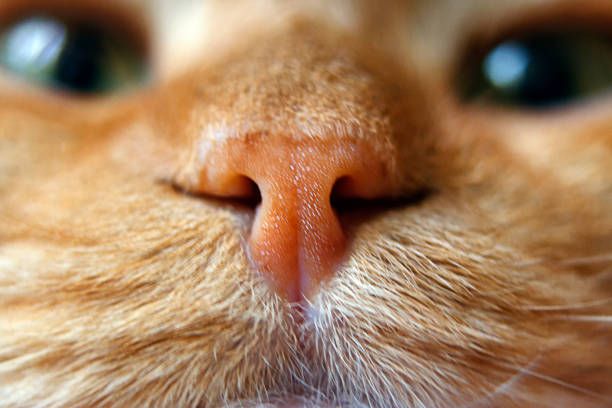Catnip, also known as catmint, is a plant from the Nepeta genus in the mint family (1). The scientific name for catnip is Nepeta Cataria. It contains an organic compound called nepetalactone, which is the psychoactive substance that induces a euphoric response when cats smell or ingest catnip (2). Catnip has a long history of use, dating back to ancient Roman times, where it grew wild in the city of Nepeta. Ancient Romans used catnip in cooking, medicine, and as an insect repellent (3).
The response that cats have to catnip is well documented. When cats smell catnip, it binds to receptors in their nose that stimulate sensory neurons and trigger a euphoric reaction (2). However, the reason why catnip affects cats but not humans has remained an enduring mystery and topic of fascination.
Chemical Composition
The key active chemical compound that causes the response in cats is called nepetalactone. Nepetalactone is an organic compound that belongs to the class of chemicals known as iridoids [1]. It is found in the essential oil of catnip plants and acts as a cat attractant. When cats inhale nepetalactone, it binds to receptors in the cat’s olfactory epithelium tissue, which triggers a response in the central nervous system. This causes the changes in behavior and mood that are commonly observed when cats are exposed to catnip, such as rolling, rubbing, licking, and excitability.
Nepetalactone is the essential oil of the catnip plant that gives it its characteristic minty aroma. The concentration of nepetalactone can vary depending on the species of catnip, ranging from 30% to almost 100% of the essential oil. The isomer known as (4aS,7S,7aR)-nepetalactone is the most potent isomer for attracting cats [2].
Catnip’s Effect on Cats

Catnip contains an oil called nepetalactone that elicits a euphoric response in cats when they smell it (PetMD). When cats sniff catnip, they often display behaviors like rolling around, flipping over, rubbing against things, and zoning out (The Humane Society). They may start meowing or making other vocalizations and become hyperactive. The reasons why catnip affects cats in this way are not fully understood, but theories include that the herb resembles feline pheromones and triggers a sexual response. Catnip may also mimic a cat pheromone called feline facial pheromone that has relaxing properties, eliciting a tranquilizing effect. However, the responses are not sexual in nature and even cats that are desexed respond in this way. Regardless of the mechanism, exposure to nepetalactone seems to trigger a pleasurable neurologic reaction in domestic cats.
Catnip Receptors
Cats have a highly developed sense of smell thanks to the abundance of olfactory receptors in their noses. Cats have over 200 million odor sensors compared to only around 5 million in humans. This makes a cat’s sense of smell about 14 times more sensitive than a human’s.
When a cat inhales the nepetalactone compounds found in catnip, the volatile molecules bind to olfactory receptors in the nasal cavity and sinuses. This triggers neural pathways that lead to the olfactory bulb and then the amygdala and hypothalamus areas of the brain. The amygdala processes emotions while the hypothalamus produces hormones and neurotransmitters that induce euphoric effects.
Though the exact mechanism is still being studied, scientists believe catnip affects cats by acting on receptors in the amygdala and hypothalamus similarly to cannabinoids like THC in marijuana. This causes the relaxed, blissful, and playful reactions that catnip elicits in cats.

Human Olfactory System Differences
The main reason humans are not affected by catnip is due to differences in our olfactory systems compared to cats. Humans have about 5 million odor receptors in their noses, while cats have over 200 million (https://www.rover.com/blog/how-far-can-cats-smell/). This allows cats to detect a much wider range of scents and odors than humans can. Additionally, cats have a secondary olfactory system called the vomeronasal or Jacobson’s organ, which detects pheromones and other chemical signals. Humans lack this organ entirely.
Specifically in the case of catnip, cats possess olfactory receptors that allow them to detect and respond to the active chemical compounds in catnip, called nepetalactones. However, humans lack the specific nepetalactone receptors that cause the euphoric response in cats (https://animalwellnessmagazine.com/cats-senses/). So even though humans can technically smell catnip, we don’t become stimulated or affected by it the way cats do.
Genetic Differences
Catnip’s effects stem from genetic differences between cats and humans. Studies comparing cat and human genomes have identified key variations tied to the response to nepetalactone, the essential oil in catnip that causes euphoric effects in cats.
Researchers at John’s Hopkins University sequenced the cat genome and identified differences in the olfactory receptors compared to humans. Cats have a modified receptor gene that binds nepetalactone and triggers a euphoric response. Humans lack this specific gene modification, so catnip has no effect.
According to the study published in PLoS One, two olfactory receptor genes isolated in cats, OR2AG1 and OR4A16, are responsible for detecting catnip compounds. These receptor genes are absent in humans, meaning catnip binds nowhere in the human nose or brain.
The researchers concluded, “The presence in the cat of a functional gene that is a pseudogene in other species suggests that this gene conferred a selective advantage, likely related to the behavioral response that contributes to catnip being an ecologically significant plant for cats.”

Improbable Explanations
There are a few common myths and improbable explanations for why catnip affects cats but not humans:
Some people claim catnip gives cats a “high” like a recreational drug would in humans. However, research shows catnip does not actually cause intoxication or addiction [1]. The chemical reaction is very different from something like opium or marijuana.
Another myth is that catnip mimics feline pheromones/hormones related to sexual attraction or territorial marking. But studies found catnip reactions still occur even if cats’ scent glands are removed [2], disproving this theory.
Some speculate catnip triggers an adrenaline rush, but research shows neurotransmitter binding, not adrenaline, induces the response [3]. The relaxed, rolling reaction is not consistent with adrenaline release.
In summary, catnip affects cats through a specific chemical reaction, not getting high, pheromones, or adrenaline. The true mechanism is more complex, as explained next.
Anecdotal Human Responses
Some people report experiencing mild effects from catnip such as relaxation, euphoria, and sleepiness. However, the effects on humans are not well researched. Some theorize that catnip may have a mild sedative effect on humans if consumed in large quantities. One study found some people experience headaches or vomiting after consuming catnip tea or smoked catnip [1]. However, any psychoactive effect from catnip on humans is likely very minor if present at all. The mild relaxing effect some people report may be a placebo effect rather than a pharmacological response. More research is needed to determine if catnip has any actual perceptible effects on humans beyond placebo.
Potential Medical Applications
Catnip contains chemical compounds called nepetalactones that are known to have several pharmacological effects. Ongoing research is exploring potential medical uses of nepetalactones in humans.
One study found that nepetalactone exhibits antibacterial and antifungal properties (https://www.ncbi.nlm.nih.gov/pmc/articles/PMC1480656/). Researchers are investigating its potential as a natural pesticide or food preservative.
Other research shows nepetalactones have sedative and analgesic effects. A study on mice found that nepetalactones provide pain relief comparable to aspirin (https://www.sciencedirect.com/topics/agricultural-and-biological-sciences/nepeta-cataria). More research is needed, but catnip compounds may eventually have applications as natural pain relievers or sedatives.

Overall, while catnip affects cats and humans differently, ongoing medical research provides hope that catnip’s active chemicals could have therapeutic potential if proven safe and effective in human trials.
Conclusion
The question of why humans are unaffected by catnip is a fascinating one. In summary, the key reasons appear to be:
1) Catnip contains nepetalactone and other compounds that bind to feline olfactory receptors, triggering a response. Humans lack these specific receptors.
2) There are genetic differences between cats and humans, particularly in their olfactory systems, that make cats sensitive while humans remain unaffected.
3) Claims of catnip impacting some humans seem to be anecdotal and not widely substantiated.
4) While unlikely to cause a high in humans like it does for cats, catnip may have minor sedative effects that could benefit medical applications.
There are still open questions that require further research. We do not fully understand all the nuances between feline and human olfactory systems. The anecdotal human reactions to catnip also warrant studies to determine if any compounds may rarely affect people.
Overall, this examination into why cats uniquely respond to catnip highlights the fascinating differences between species. While humans remain mysteriously unaffected, ongoing research and genetic mapping continues to unravel the secrets behind cats’ affinity for catnip.

